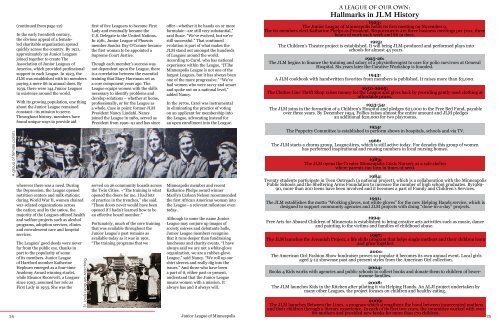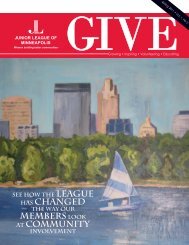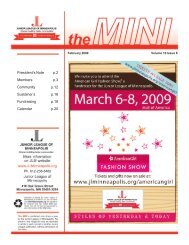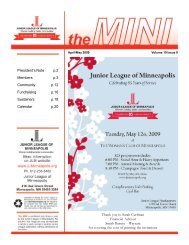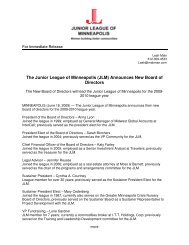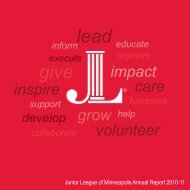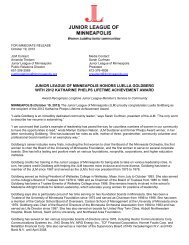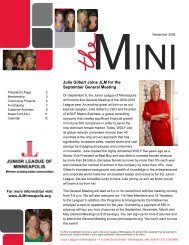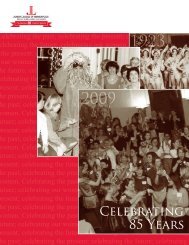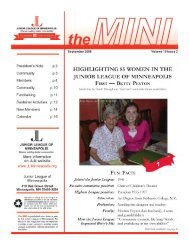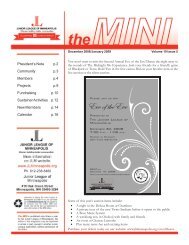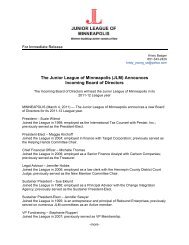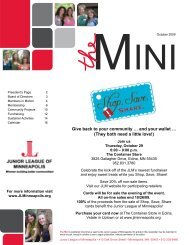Giving - Junior League of Minneapolis
Giving - Junior League of Minneapolis
Giving - Junior League of Minneapolis
You also want an ePaper? Increase the reach of your titles
YUMPU automatically turns print PDFs into web optimized ePapers that Google loves.
A group <strong>of</strong> female poliots<br />
(continued from page 22)<br />
In the early twentieth century,<br />
the obvious appeal <strong>of</strong> a femaleled<br />
charitable organization spread<br />
quickly across the country. By 1921,<br />
approximately 30 <strong>Junior</strong> <strong>League</strong>s<br />
joined together to create The<br />
Association <strong>of</strong> <strong>Junior</strong> <strong>League</strong>s <strong>of</strong><br />
America, which provided pr<strong>of</strong>essional<br />
support to each <strong>League</strong>. In 1923, the<br />
JLM was established with 60 members<br />
paying a mere $6 in annual dues. By<br />
1939, there were 144 <strong>Junior</strong> <strong>League</strong>s<br />
in existence around the world.<br />
With its growing population, one thing<br />
about the <strong>Junior</strong> <strong>League</strong> remained<br />
constant—its mission to serve.<br />
Throughout history, members have<br />
found unique ways to provide aid<br />
wherever there was a need. During<br />
the Depression, the <strong>League</strong> opened<br />
nutrition centers and milk stations;<br />
during World War II, women chaired<br />
war-related organizations across<br />
the nation; and by the 1960s, the<br />
majority <strong>of</strong> the <strong>League</strong>s <strong>of</strong>fered health<br />
and welfare projects such as alcohol<br />
programs, adoption services, clinics<br />
and convalescent care and hospital<br />
services.<br />
The <strong>League</strong>s’ good deeds were never<br />
far from the public eye, thanks in<br />
part to the popularity <strong>of</strong> some<br />
<strong>of</strong> its members. <strong>Junior</strong> <strong>League</strong><br />
<strong>of</strong> Hartford member Katherine<br />
Hepburn emerged as a four-time<br />
Academy Award winning starlet,<br />
while Eleanor Roosevelt, a <strong>League</strong>r<br />
since 1903, assumed her role as<br />
First Lady in 1933. She was the<br />
St. Louis <strong>League</strong>rs Marching<br />
first <strong>of</strong> five <strong>League</strong>rs to become First<br />
Lady and eventually became the<br />
U.S. Delegate to the United Nations.<br />
In 1981, <strong>Junior</strong> <strong>League</strong> <strong>of</strong> Phoenix<br />
member Sandra Day O’Conner became<br />
the first woman to be appointed a<br />
Supreme Court Justice.<br />
Though each member’s success was<br />
not dependent upon the <strong>League</strong>, there<br />
is a correlation between the essential<br />
training that Mary Harriman set as<br />
a core component years ago. The<br />
<strong>League</strong> equips women with the skills<br />
necessary to identify problems and<br />
develop solutions – whether at home,<br />
pr<strong>of</strong>essionally, or for the <strong>League</strong> as<br />
a whole. Case in point: former JLM<br />
President Nancy Lindahl. Nancy<br />
joined the <strong>League</strong> in 1980, served as<br />
President from 1990–91 and has since<br />
served on 26 community boards across<br />
the Twin Cities. ¬“The training is what<br />
opened the doors for me. I had lots<br />
<strong>of</strong> practice in the trenches,” she said.<br />
“Those doors never would have been<br />
opened if I hadn’t learned how to be<br />
an effective board member.”<br />
Fortunately, much <strong>of</strong> the core training<br />
that was available throughout the<br />
<strong>Junior</strong> <strong>League</strong>’s past remains as<br />
available today as it was in 1901.<br />
“The training programs that we<br />
<strong>of</strong>fer—whether it be hands on or more<br />
formulaic—are still very substantial,”<br />
said Suzie. “We’ve evolved, but we’re<br />
still successful.” That continued<br />
evolution is part <strong>of</strong> what makes the<br />
JLM stand out amongst the hundreds<br />
<strong>of</strong> <strong>League</strong>s around the world.<br />
According to Carol, who has national<br />
experience within the <strong>League</strong>, “[T]he<br />
<strong>Minneapolis</strong> <strong>League</strong> is not one <strong>of</strong> the<br />
largest <strong>League</strong>s, but it has always been<br />
one <strong>of</strong> the more progressive.” “We’ve<br />
had women who were savvy and smart<br />
and spoke out on a national level,”<br />
added Nancy.<br />
In the 1970s, Carol was instrumental<br />
in eliminating the practice <strong>of</strong> voting<br />
on an applicant for membership into<br />
the <strong>League</strong>, advocating instead for<br />
an open enrollment into the <strong>League</strong>.<br />
<strong>Minneapolis</strong> member and recent<br />
Katharine Phelps award winner<br />
Marilyn Carlson Nelson recommended<br />
the first African American woman into<br />
the <strong>League</strong>—a relevant milestone even<br />
today.<br />
Although to some the name <strong>Junior</strong><br />
<strong>League</strong> may conjure up images <strong>of</strong><br />
society soirees and debutante balls,<br />
<strong>Junior</strong> <strong>League</strong> members recognize<br />
that it runs deeper than fundraising<br />
luncheons and charity events. “I have<br />
always said we are not a white-glove<br />
organization, we are a rubber-glove<br />
<strong>League</strong>,” said Nancy. “We roll up our<br />
shirt sleeves and really dig into the<br />
issues.” And those who have been<br />
a part <strong>of</strong> it, either past or present,<br />
understand that the <strong>Junior</strong> <strong>League</strong><br />
means women with a mission. It<br />
always has and it always will.<br />
A <strong>League</strong> <strong>of</strong> Our Own:<br />
Hallmarks in JLM History<br />
1923:<br />
The <strong>Junior</strong> <strong>League</strong> <strong>of</strong> <strong>Minneapolis</strong> holds its first meeting on November 9.<br />
The 60 members elect Katharine Phelps as President. Requirements are three business meetings per year, three<br />
hours <strong>of</strong> work each week and $6 in dues.<br />
1925:<br />
The Children’s Theatre project is established. It will bring JLM-produced and performed plays into<br />
schools for almost 45 years.<br />
1925-26:<br />
The JLM begins to finance the training and salary <strong>of</strong> a physiotherapist to care for polio survivors at General<br />
Hospital. Six years later the Curative Workshop is founded.<br />
1943:<br />
A JLM cookbook with handwritten favorites from members is published. It raises more than $3,000.<br />
1950-2005:<br />
The Clothes Line Thrift Shop raises money for the <strong>League</strong> and gives back by providing gently used clothing at<br />
affordable prices.<br />
1953-54:<br />
The JLM joins in the formation <strong>of</strong> a Children’s Hospital and pledges $21,000 to the Free Bed Fund, payable<br />
over three years. By December 1954, Follies raises almost the entire amount and JLM pledges<br />
an additional $20,000 for two playrooms.<br />
1954:<br />
The Puppetry Committee is established to perform shows in hospitals, schools and via TV.<br />
1966:<br />
The JLM starts a chorus group, <strong>League</strong>Aires, which is still active today. For decades this group <strong>of</strong> women<br />
has performed inspirational and rousing numbers in local nursing homes.<br />
1983:<br />
The JLM opens the Greater <strong>Minneapolis</strong> Crisis Nursery as a safe shelter<br />
where parents can turn in times <strong>of</strong> need.<br />
1984:<br />
Twenty students participate in Teen Outreach (a national project), which is a collaboration with the <strong>Minneapolis</strong><br />
Public Schools and the Sheltering Arms Foundation to increase the number <strong>of</strong> high school graduates. By1989-<br />
90, more than 200 teens have been involved and it becomes a part <strong>of</strong> Family and Children’s Services.<br />
1991:<br />
The JLM establishes the motto “Working gloves, not white gloves” for the new Helping Hands service, which is<br />
designed to support community agencies and JLM projects with doing “done-in-a-day” projects.<br />
1994:<br />
Free Arts for Abused Children <strong>of</strong> Minnesota is established to bring creative arts activities such as music, dance<br />
and painting to the victims and families <strong>of</strong> childhood abuse.<br />
1997:<br />
The JLM launches the Jeremiah Project, a life skills program that helps single mothers and their children learn<br />
and grow together.<br />
2001:<br />
The American Girl Fashion Show fundraiser proves so popular it becomes its own annual event. Local girls<br />
aged 5-12 showcase past and present styles from the American Girl collection.<br />
2004:<br />
Books 4 Kids works with agencies and public schools to collect books and donate them to children <strong>of</strong> lowerincome<br />
families.<br />
2008:<br />
The JLM launches Kids in the Kitchen after piloting it via Helping Hands. An ALJI project undertaken by<br />
many other <strong>League</strong>s, the project focuses on children and healthy eating.<br />
2009:<br />
The JLM launches Between the Lines, a program which strengthens the bond between incarcerated mothers<br />
and their children through a literary experience. In each <strong>of</strong> its first two years, the committee worked with over<br />
80 mothers and provided new books for more than 170 children.<br />
24 <strong>Junior</strong> <strong>League</strong> <strong>of</strong> <strong>Minneapolis</strong><br />
25


